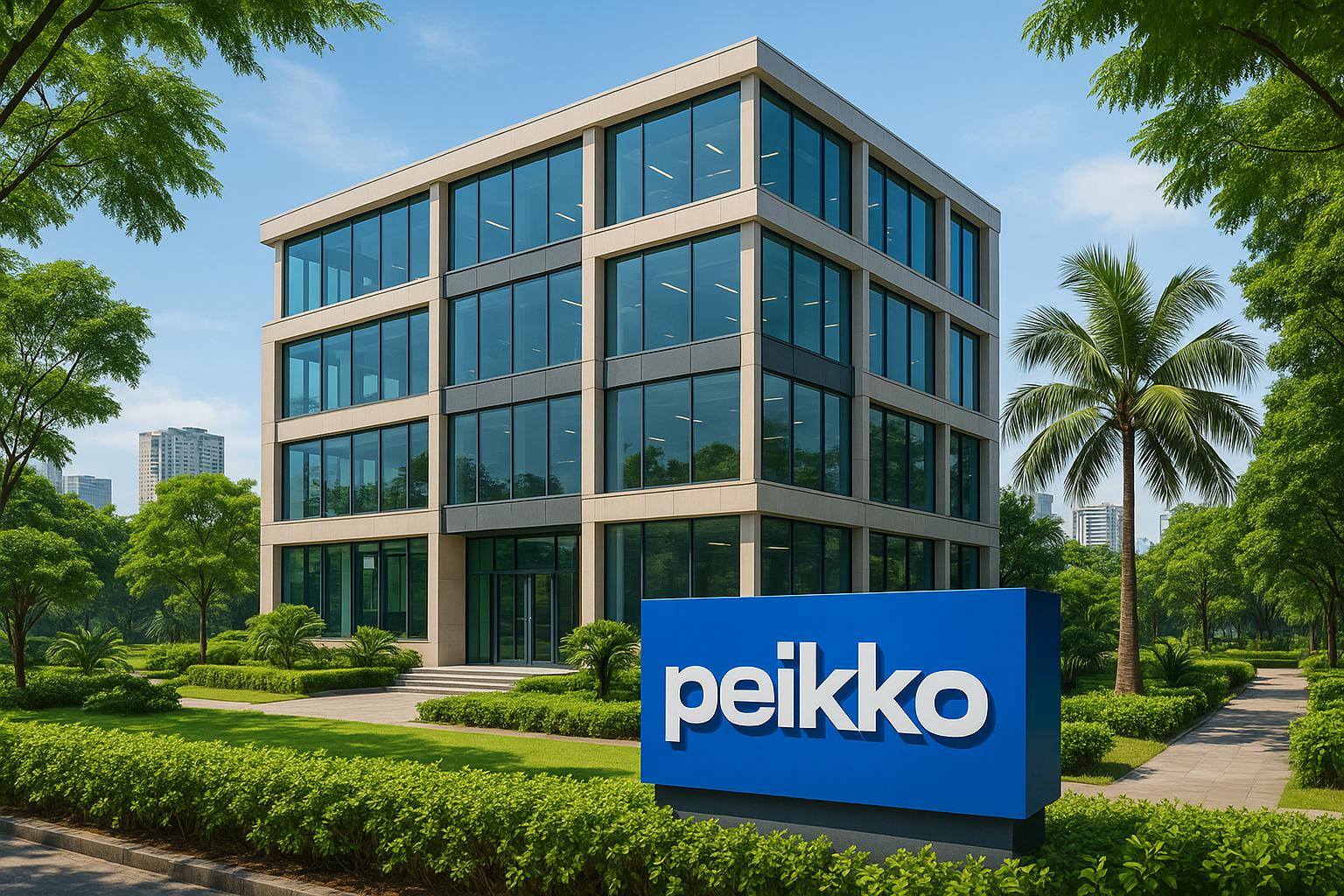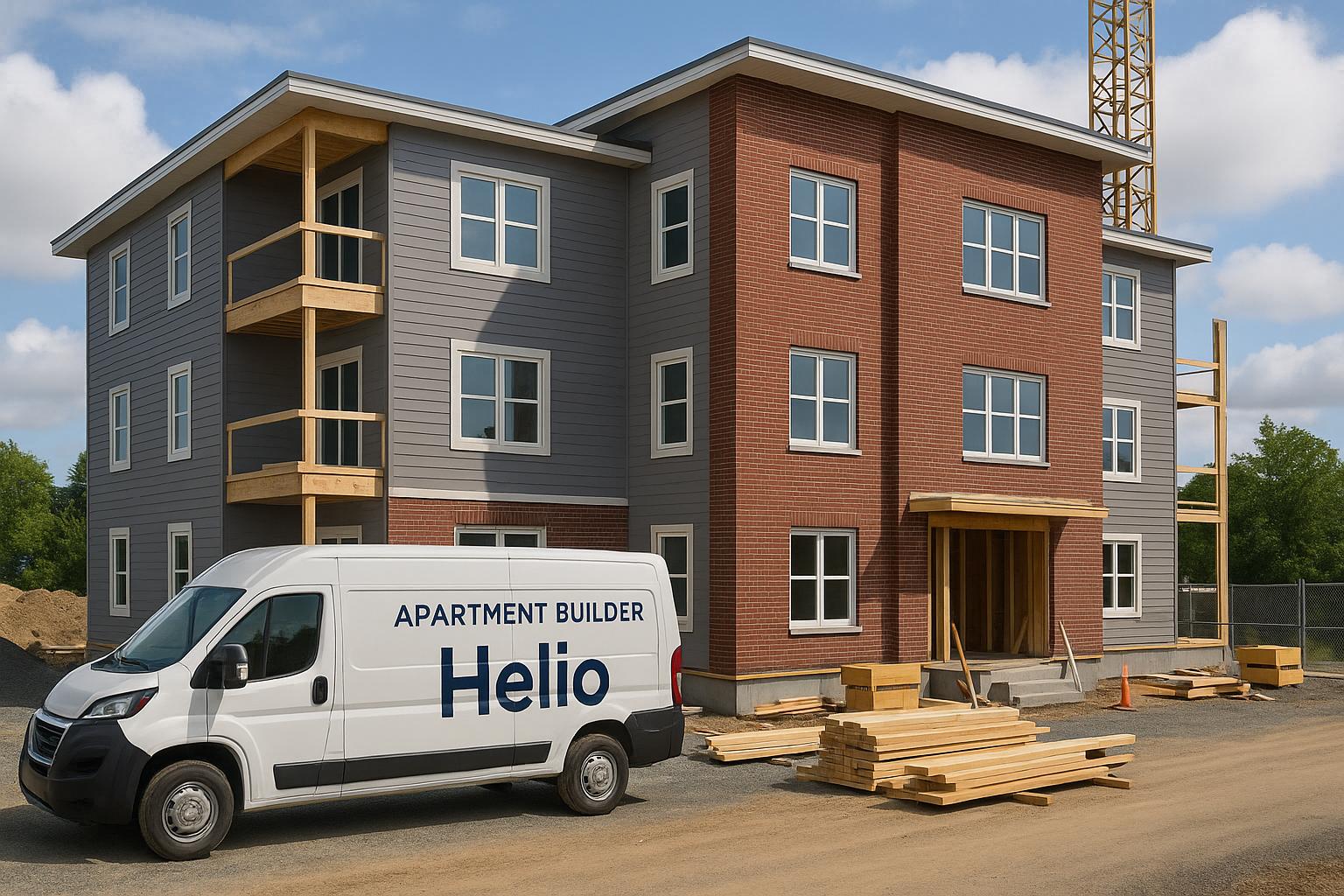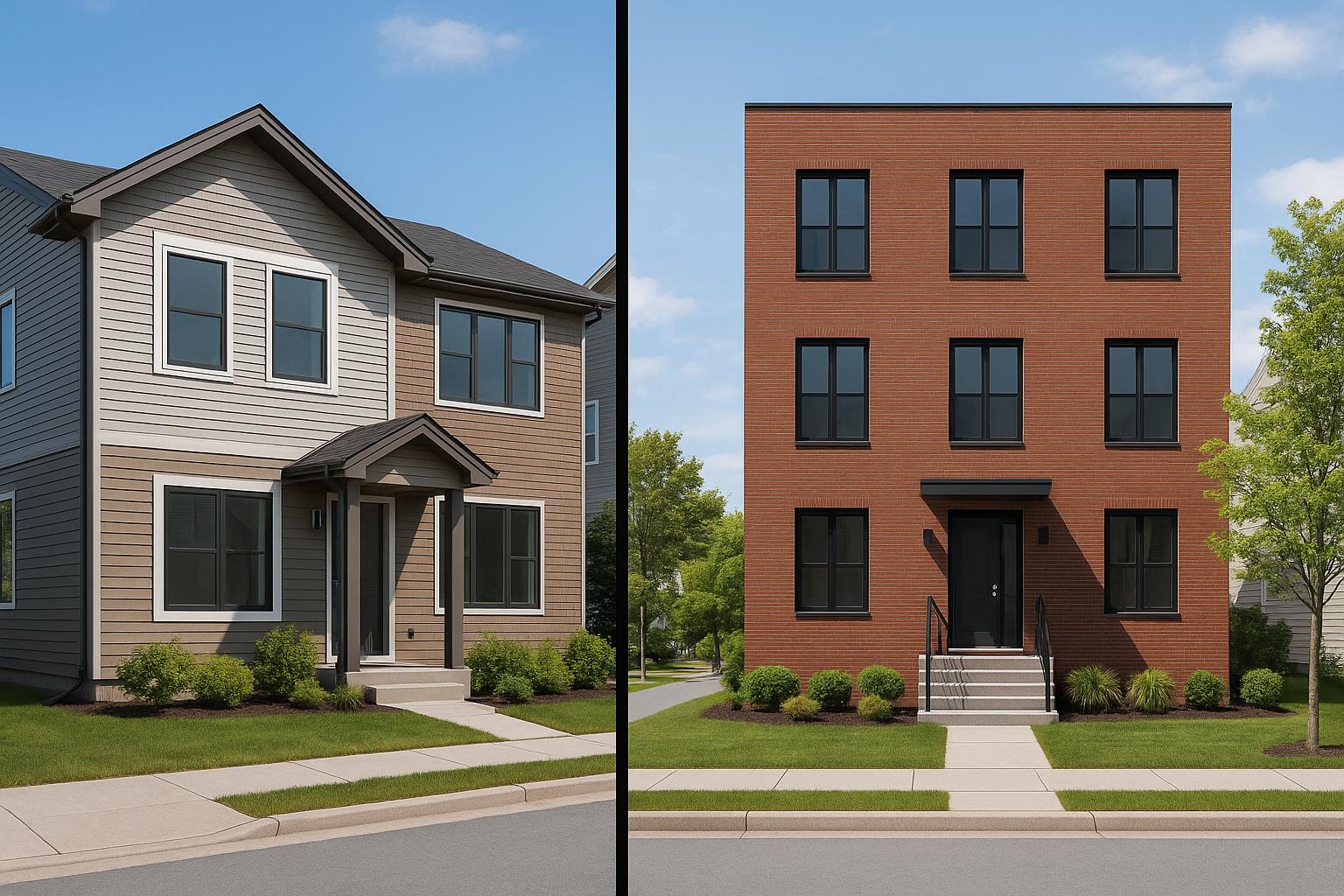Halifax faces a growing housing crisis. In 2024, the city’s population grew by 11,600, reaching 503,037, driven mainly by international migration. However, only 4,691 housing units were built, leaving a shortfall of 17,500 homes. This gap is expected to widen to 31,000 by 2027.
Key facts:
- Population growth: 2.4% in 2024, with 12,931 newcomers (80% from international migration).
- Housing supply: 4,691 units built in 2024 vs. demand for 11,600 residents.
- Costs: Average rent for a two-bedroom unit rose to $1,707 in 2024, and house prices increased 77% since 2020.
- Homelessness: Reached 3,295 as of March 2025.
Halifax’s housing shortage is driving up rents and home prices, straining affordability for residents. The solution lies in faster, more efficient construction methods and streamlined policies to address the demand-supply imbalance.
Halifax Population Growth Numbers
Population Growth Data 2022–2025
Halifax has experienced a notable population boom over the last few years, though the pace has recently slowed. In 2024, the city reached a significant milestone, surpassing 503,037 residents [1].
The growth unfolded in distinct phases. In 2022, Halifax welcomed 12,688 new residents, marking a 2.8% increase [2]. The following year, 2023, saw the largest single-year jump, with 19,237 new residents, a 4.1% rise that brought the total population to 492,199 [2]. By 2024, growth had moderated, with an additional 11,600 residents, representing a 2.4% increase [1].
| Year | Population | Annual Growth | Growth Rate |
|---|---|---|---|
| 2022 | 472,962 | 12,688 | 2.8% |
| 2023 | 492,199 | 19,237 | 4.1% |
| 2024 | 503,037 | 11,600 | 2.4% |
The Halifax metropolitan area followed a similar trend, expanding from 423,000 residents in 2024 to an estimated 426,000 in 2025 [8]. These figures provide context for the factors driving Halifax's population increase.
What Drives Population Growth
Halifax's population surge has been largely fuelled by international migration. In 2023, international migration brought 15,776 new residents, accounting for the majority of the year's growth. In 2024, this trend continued with 12,931 new residents, representing about 80% of the total increase [1] [2]. That year, the city admitted 26,635 international migrants, though this marked a 4% decline compared to the previous year [1].
Changes in other migration patterns were also significant. For the first time since 2015, interprovincial migration turned negative in 2024, as Halifax lost 419 residents to other provinces. This was a sharp contrast to 2023, when interprovincial migration added 3,300 individuals, making up 17% of the growth [1] [2]. Additionally, natural population growth turned negative in 2024, with 322 more deaths than births, alongside a loss of 590 residents due to intraprovincial migration [1].
The city also saw a decline in study permit holders, with 5,610 arriving in 2024, a 21% drop from the previous year [1].
How Population Growth Affects Housing Demand
Halifax's rapid population growth has placed increasing pressure on its housing market. The city's demographic profile is shifting younger, with the median age dropping to 39.0 years in 2023, the lowest since 2009 [2]. This younger population is driving demand for rental housing, particularly multi-unit properties.
From 2022 to 2024, Halifax added over 43,000 new residents, intensifying the strain on housing supply. Vacancy rates for apartments hit a historic low of 1.0% in 2023, a trend that began in 2021 [10]. Although the vacancy rate rose slightly to 2.1% by late 2024, it remained below the 10-year average of 2.7% [10].
International migrants, who often rely on rental housing, have significantly impacted demand for affordable units. Apartments renting for under $1,300 per month saw vacancy rates below 1% [10]. Meanwhile, the demand for larger units has grown, as many migrants arrive with families or as young professionals. By 2024, the average rent for a two-bedroom apartment reached $1,707, a 3.8% increase from the previous year [10].
"Halifax's population continues to grow faster than its housing stock. This disparity exacerbates competition for available units and drives up prices across the market, further limiting access to affordable housing."
– Donna Williamson, Chief Executive Officer, Habitat for Humanity Nova Scotia [9]
The housing shortage has also highlighted the need for "missing middle" housing, such as duplexes, triplexes, townhouses, and small-scale multi-unit buildings. These options could provide more affordable alternatives to single-family homes [10]. However, the challenges remain stark: as of March 5, 2025, Halifax's homeless population reached 3,295 individuals, underscoring the difficulty of meeting housing demands in the face of rapid growth and rising costs [5].
Halifax Housing Supply Status
New Housing Units vs Population Increases
In 2024, Halifax completed 3,179 new housing units - falling far short of the 11,600 residents added that year. This left a significant gap of 8,400 units. While housing starts reached 4,691 units, another 9,954 units remained under construction. Even with these efforts, the city faces a housing shortfall of 17,500 units, which could grow to 31,000 by 2027 [1][4][12]. This persistent shortage directly influences vacancy rates and rental prices, as explored below.
"Housing starts and completions still lag population growth, although the gap is narrowing." [4]
Vacancy Rates and Housing Costs
Halifax's vacancy rate rose from 1.0% (2021–2023) to 2.1% in 2024, thanks to new housing completions. However, this is still below the 10-year average of 2.7% [4]. Meanwhile, rents continued climbing. The average monthly rent increased by 6.4% in 2024, reaching $1,636. By May 2025, asking rents for two-bedroom apartments had surged to $2,623 [4][13]. Since 2015, rents have soared by 68%, far outpacing Nova Scotia's 5% rent cap. Although the rent growth rate slowed from 13.8% in 2023 to 6.4% in 2024, affordability remains a pressing concern.
| Rental Market Indicator | 2023 | 2024 | Change |
|---|---|---|---|
| Vacancy Rate | 1.0% | 2.1% | +1.1% |
| Average Monthly Rent | $1,537 | $1,636 | +6.4% |
| Rent Growth Rate | 13.8% | 6.4% | -7.4% |
Construction Delays and Barriers
Halifax's rental market remains under pressure, and construction challenges are making the situation worse. High interest rates and ongoing labour shortages are delaying housing projects [7]. Land costs have skyrocketed, jumping from approximately $60,000 to $200,000 per plot. On top of that, development fees now range from $10,000 to $15,000 per unit, significantly increasing project expenses [12]. Zoning restrictions, lengthy permitting processes, and rising municipal fees add further complications.
Recent initiatives aim to speed up construction. These include the federal government's $79 million Housing Accelerator Fund, new zoning policies allowing up to four units per lot, and relaxed parking requirements [12]. While permit issuances grew by 102% between 2010 and 2022 [7], community opposition and regulatory hurdles still cause delays.
"At a time when housing affordability is already a significant issue in our city, additional tax increases will exacerbate the situation." [12]
The Housing Gap: Population Growth vs Housing Supply
Measuring the Housing Gap
Halifax is experiencing a striking imbalance between its booming population growth and the availability of new housing. Although the city is set to see nearly 4,700 new housing units built in 2024, this falls far short of the demand, leaving a deficit of 17,500 units. If this trend continues, the shortfall could balloon to 31,000 units by 2027 [12]. This mismatch is already reshaping the dynamics of both the rental and home-buying markets.
"For a long time, we have been concerned about demographic and population growth... In the last couple of years, the concern shifted slightly to the recognition that we still want and need people long term, we need that growth, we need those people coming here, but a lot came really quickly and it put some pressure on our housing market, health-care system and on the roads in terms of traffic and the transit system."
– Ian Munro, chief economist for the Halifax Partnership [6]
Impact on Rental and Purchase Markets
This housing shortage is creating ripple effects across Halifax's real estate landscape. On the home-buying side, prices continue to climb. In 2024, the average home price reached $578,913 - a 4.4% increase from the previous year [11]. Detached homes now average $688,898, while townhouses and apartments are priced at approximately $472,313 and $495,870, respectively [5]. Between 2019 and 2022, median home prices skyrocketed by 67% [12]. Meanwhile, home sales rose by 8% in 2024, with 4,508 transactions compared to 4,173 in 2023 [11].
The rental market faces its own pressures. When rental units become available, landlords are charging turnover rents that average 28% higher than the rates paid by previous tenants [10]. This trend underscores the growing strain on affordability, making it harder for many to find stable housing.
Future Consequences of Housing Shortages
The housing gap doesn't just affect affordability - it also puts a strain on infrastructure and regional planning. Vulnerable populations are particularly at risk, and the lack of housing is driving urban sprawl into neighbouring areas. This expansion adds pressure to regional infrastructure and increases commute times for residents [3]. Despite Halifax adding 13,900 new jobs in 2024, the ongoing housing shortage makes it harder to attract and retain skilled workers [6].
"It's a 'two sides of the same coin' story. It's good that we had a pretty robust population growth again in 2024, the third highest we have ever experienced, but it was down significantly from the two years before. People are still coming here and we want that to continue, but they are not coming quite so quickly, so we can allow our infrastructure and systems to catch up a little bit."
– Ian Munro, chief economist for the Halifax Partnership [6]
Halifax faces a pivotal challenge: ramp up housing construction to keep pace with population growth or risk deepening affordability and infrastructure issues. Without more efficient and reliable construction practices, the housing gap is likely to grow even wider in the coming years.
Closing Halifax's Housing Gap
Problems with Standard Construction Methods
Halifax property owners face significant challenges when relying on traditional construction methods to address the housing shortage. The fragmented nature of contracting often leads to chaos and extended timelines. What should take about eight months can drag on for over 18 months. Miscommunication between disjointed teams results in delays, budget overruns of 30–60%, and a lack of accountability. These inefficiencies make it clear that a more streamlined approach is needed.
"We've kind of grown accustomed to a certain way of building with wood framing, where we're building everything on site." - Dan Winer, executive lead at Small Housing BC [14]
Integrated Design-Build Construction
A solution to these long-standing issues lies in integrated design-build construction. This approach consolidates all aspects of a project under one company, eliminating the need for property owners to juggle multiple contracts and coordinate between various teams. In a city like Halifax, where housing demand far exceeds supply, this unified method offers a way forward.
"Integrating the design and construction phases can result in faster project completion and reduced timelines." - Stronghold Engineering [15]
By merging design and construction into a single process, this method tackles delays head-on. With one entity overseeing everything - from securing permits to final inspections - accountability is clear and streamlined [16]. Early collaboration between designers and builders also means more accurate cost estimates, reducing the risk of unexpected expenses that can derail projects [16].
Helio Urban Development, Nova Scotia’s only integrated design-build company, provides a compelling example of this approach in action. They deliver fixed-price construction at $160,000 per unit within six months, and they back their timelines with penalties of up to $1,000 per day for delays. By bringing together planners, architects, engineers, and construction teams, they eliminate the coordination issues that typically slow down traditional projects.
Faster Multi-Unit Housing Construction
For property owners looking to speed up multi-unit housing projects, practical steps are available. Integrated teams working in close collaboration ensure consistent and cost-effective outcomes [18].
Additionally, exploring pre-approved building plans can streamline the approval process. The Halifax Regional Municipality is actively working to fast-track housing development by improving permitting systems and promoting standardised designs [17].
For those ready to build, companies like Helio Urban Development are already making strides. They currently have 31 units under construction across Nova Scotia, with plans for an additional 131 units. Their two-bedroom rental units, priced for monthly rents of $1,950–$2,100, offer an annual ROI of 12–20%. Serving all municipalities within a 90-minute radius of Halifax, this systematic approach is helping to address the city’s 17,500-unit housing shortfall while overcoming the inefficiencies of traditional construction methods.
sbb-itb-16b8a48
The Affordable Housing Crisis in Nova Scotia Explained
Conclusion: Matching Housing Supply to Population Growth
Halifax is grappling with a housing crisis that demands urgent action. With a shortfall of nearly 20,000 units, coupled with rising rents and low vacancy rates, the situation is dire [19].
"Halifax's population continues to grow faster than its housing stock. This disparity exacerbates competition for available units and drives up prices across the market, further limiting access to affordable housing." – Donna Williamson, Chief Executive Officer, Habitat for Humanity Nova Scotia [9]
The path forward lies in speeding up and simplifying the construction process. Traditional methods, often plagued by delays and cost overruns, no longer meet the urgency of the current demand. Reform is needed - not just in policy but also in how housing projects are executed.
On the policy side, Halifax is already making strides. The Halifax Regional Municipality is working on revising planning frameworks through the Canada Mortgage and Housing Corporation Housing Accelerator Fund Program. The aim? To increase density and cut through regulatory red tape [19]. These efforts are beginning to pay off. As Kent Roberts, Vice President of Policy at the Halifax Chamber of Commerce, explains, "a faster and improved regulatory environment has significantly increased the number of units being built in the HRM" [9].
But policy changes alone won't solve the problem. Developers and property owners need construction partners who can deliver projects on time and within budget. Companies like Helio Urban Development are setting a strong example. Their integrated design-build model promises fixed-price construction within six months, with financial penalties for delays. This kind of approach tackles the systemic inefficiencies that have long slowed housing production.
To close the housing gap, Halifax needs both streamlined regulations and construction practices that prioritize accountability and speed. With home prices projected to climb by 5.0% to $607,859 in 2025 and the homeless population reaching 3,295 as of March 5, 2025 [5], the stakes couldn't be higher.
Addressing this crisis will require collaboration across the board - from municipal leaders reforming policies to developers and property owners committing to timely, quality builds. Halifax has the momentum and tools to tackle its housing shortage. The challenge now is ensuring construction keeps pace with the city’s rapid population growth.
FAQs
How can Halifax address its housing shortage caused by rapid population growth?
Halifax faces a pressing need to address its housing shortage, with an estimated demand for 8,000 new homes each year. To meet this challenge, increasing the number of housing units is essential. One effective approach is implementing zoning reforms that encourage higher-density developments, such as fourplexes and larger rental buildings. These changes can maximize the use of available land and significantly expand the housing supply.
Another solution lies in embracing modern construction methods, like integrated design-build approaches, which streamline the building process. These methods can help control costs, reduce delays, and ensure projects are completed efficiently. For instance, fixed-price construction models offer property owners greater predictability and faster completion times, making it easier to bridge the housing gap.
Halifax can also take cues from broader efforts, such as Canada’s National Housing Strategy. This initiative emphasizes simplifying housing development processes and expanding inventory to meet growing demand - a framework that could serve as a valuable blueprint for the city.
What challenges does Halifax's housing shortage create for vulnerable populations and city infrastructure?
Halifax's Housing Shortage: A Growing Concern
Halifax's housing shortage is hitting vulnerable populations the hardest. For low-income families and marginalized groups, finding affordable and stable housing has become increasingly difficult. This not only widens social and economic gaps but also raises the risk of homelessness for those already living on the edge.
The housing crunch is also taking a toll on the city's infrastructure. With demand outpacing supply, essential systems like water, wastewater, and public transit are under strain. Traffic congestion is worsening, and service delivery is slowing down. Tackling these challenges is crucial if Halifax is to grow in a way that benefits everyone.
How can integrated design-build construction help address Halifax's housing shortage more effectively than traditional methods?
Integrated Design-Build Construction: A Solution for Halifax's Housing Shortage
Halifax is growing fast, and with that growth comes the pressing need for more housing. One way to tackle this challenge is through integrated design-build construction. This method brings together the design and construction phases under a single team, simplifying the process. By doing so, it avoids the typical coordination headaches, cuts down on delays, and speeds up project completion - something Halifax desperately needs to keep up with demand.
What sets integrated design-build apart from traditional methods is its focus on efficiency and accountability. With fixed-price contracts and a single team responsible for the entire project, property owners gain a clear understanding of costs and timelines right from the start. This approach minimizes the risk of budget overruns and lengthy delays, making it a practical and predictable choice for delivering housing quickly and affordably.



